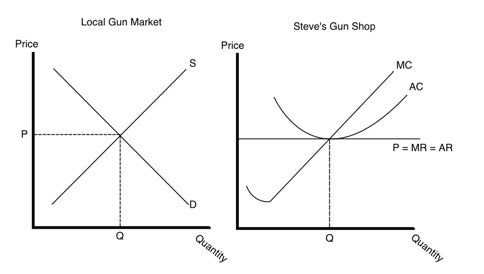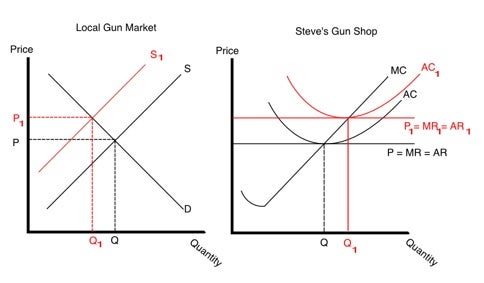Bitter, on this blog entry, had this to say about my attempt to find out who pays too much for firearms:
A) The laws aren’t consistent. If only members of the military and law enforcement can purchase firearms, it’s hardly an open market.
B) Culturally, it’s not a big thing in most other countries and that will also influence the market.
C) There is no such thing as “paying too much,” and important premise in his attempt to study prices
I am going to try to answer her 3rd point. I will try not to make this a full economics lesson. Here is an open market for guns, with no government regulation:
Ignore the diagram on the right. I have only included it for the sake of completeness.
This shows a perfect competitor, a gun dealer named Steve, and the local gun market.
The S curve shows supply. As price increases suppliers/producers are willing to produce more.
The D curve shows demand. As price decreases consumers are willing to purchase more.
The eventual price is the agreed price between suppliers and consumers. In other words where Supply=Demand (S=D). This is called the equilibrium point.
The point P is how much you should be paying for a gun.
Here is the market for a gun dealer after government regulation and compliance costs:
For anyone who has studied economics at a college level, this is showing the long term effect, I do realize that negative economic profit will be made in the short term.
As you can see above, supply decreases from S to S1 therefore driving up the cost
On the unregulated market you would pay P. Now you are paying P1.
I am sure I have made some mistakes on these diagrams. I am not trying to blog a course in microeconomics. I will leave that to the college professors!
To answer Bitter’s other points:
A) I am looking at what consumers, not the military, pay in other countries. I am really trying to find out how much government interference there is in other countries.
B) Yes, demand certainly influences price, you are right about that. Some countries will import more than others which will in turn decrease the costs per item.
I may do another post showing how world price effects gun supply and prices.
I hope that I have made sense.
This is why I am a big supporter of small government and the deregulation of all things, including firearms.
If you found this post interesting I highly recommend reading The Undercover Economist (non affiliate link).
I have been having problems with my blog and posting comments sometimes does not work. If it does not work for you please try it again.
 Your Privacy Choices
Your Privacy Choices

